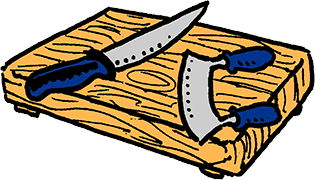
Available in either softbound or Kindle/Nook/etc. eBook at Amazon
viviansharpe.com

  16 A primer on vegan kitchen appliances, tools & gadgets One of the more intimidating aspects of going vegan is transitioning not only your eating habits but your kitchen. It seems to me like every year or so, there is a new appliance, implement or tool that is touted as absolutely essential to the plant-based kitchen and there is so much enthusiasm and cult-like obsessiveness about it until the next new appliance, implement or tool that is “absolutely essential” to the plant-based kitchen. I will give you my honest opinion: very little is really necessary, other than a knife, a spatula, a cutting board and a pan. I was vegan for a long time with little more than a cheap blender and I did just fine. That said, there are some things that will make your time in the kitchen more enjoyable and convenient and may even help you cook more often. Many people feel some of these appliances help them to eat more healthfully, too, by making it easier to consume fresh produce and whole grains from home. It is up to you and your needs as well as other considerations, like how much space you have, how practical it is for your life, etc. To create this list, I queried my many vegan friends because I have always found them to be so helpful and full of great information and I wanted to offer more than just my opinion and experience. As always, many thanks to everyone who contributed. Appliances  Pressure Cookers/Instant Pot Pressure Cookers/Instant PotWithout a doubt, the MVP in this category is the Instant Pot (or IP). Pressure cookers of yore were dangerous, unwieldy things but the IP has taken the guess work (and danger!) out of speed cooking with its pressure release button that keeps you safe (and your walls safe) and has also added a bunch of functions into one very ingenious device: Depending on your model, you can use it as a pressure cooker (of course), slow cooker, rice cooker, sauté pan, yogurt maker, steamer and warmer. In other words, it is multiple appliances in one. Enthusiasts – and there are legions – love the IP for being able to sauté veggies and easily segue into making a soup. It cooks dried beans in a fraction of the time it would take otherwise and prepares meals in minutes. Personally, I love my Instant Pot. Could I live without it? Absolutely, but it certainly makes home-cooked meals easier and quicker. Perfect for: People who want home-cooked meals fast. Slow Cookers Also known by the popular brand name Crock-Pot, slow cookers are the opposite of the pressure cooker in terms of speed but in one significant way, it has a shared quality and that is of convenience: You just combine your ingredients, set your timer, and by the time your timer dings, you’ve got a whole meal ready in one pot. With an inserted pot, lid, and base that is plugged in, modern slow cookers will also default to the warm setting if the timer goes off when you are not home and, like the Instant Pot, it is safe to leave unattended. After a quick sauté, it is pretty nifty to combine ingredients in a slow cooker, leave for work and return home to the aroma of a home-cooked meal filling the air. Some people also prefer the flavor and texture of food from the slow cooker but a drawback is it is not great preparing grains, unlike a pressure cooker, so they must usually be cooked separately. A slow-cooker pot is very useful for having at potlucks or parties: just plug in the base and keep warm. (IPs can be used similarly but don’t travel as well.) I don’t use my slow cooker as much as I once did but it is still a functional part of my kitchen. Perfect for: People who want home-cooked meals and aren’t concerned about how fast it is. Blenders Never has a kitchen item been so controversial among vegans as the high-speed blender. Want to test this? Simply ask if people prefer the Vitamix or the Blendtec on a vegan Facebook page and wait for the anger and drama to materialize. Holy criminy, people take their blenders very seriously. Okay, let me break it down: Vitamix and Blendec are both high-speed blenders, meaning that they have more power than the standard blender, which means you can use one to blend lots of fruits and veggies quickly and to a smooth consistency – which is part of why many people consider them an important part of including a good variety of produce in their lives – and also they are very useful for blending things like cashews to utter silky creaminess. High-speed blenders basically will get its contents smoother quicker, although some find other uses for it, like grinding flour. The pros and cons of a Vitamix vs. Blendtec: The Vitamix is more expensive than the Blendtec; the Blendtec is louder, though not by much. The Vitamix is taller and more narrow, which makes it less easy to fit onto all kitchen counters and the Blendtec, with a shorter, wider jar, can fit on counters better and is easier to clean due to the shape. Blendtecs do not come with a tamper, which can leave food unblended, and there are some complaints that the Blendtec lid is less secure and can pop off if left unattended. A Vitamix is heavier, which can be either a drawback or a benefit; one of the drawbacks of a Blendtec is they are best used if you keep your hand on the machine when it’s on to keep it from falling off the counter. Both brands are known for their excellent customer service and generous warranties. (I can attest to this: we have a Vitamix and it had stopped functioning – they replaced the whole jar as we were still on warranty, including the shipping both ways.) This is all to say, they are both great blenders and a splurge, though people often find substantial savings through purchasing reconditioned models on the company websites, which cost less and are usually just lightly used in-store demo models that could not be sold as new. We are very happy with our Vitamix and often use it multiple times a day. That said, I am about to say something that will be a little controversial but if you read my opening paragraph, it shouldn’t come as a surprise: I don’t think a high-speed blender is necessary. Yeah, I said it. I am very glad to have one but I was vegan for a good 18 years or so before I bought mine and I managed just fine. There are way too many people who say that a high-speed blender is a requirement to being vegan and, honestly, we need to stop with that hyperbole. Not everyone has hundreds to plunk down for a blender, okay? They are very nice to have, though. Okay, while on the subject, let’s talk about a few more blenders. For an affordable, high-quality blender, many of my friends love the Nutribullet and Ninja blender systems. If you are looking for a new blender and don’t want to make a big investment, look into these as perfectly good blenders. Second, many people I queried mentioned immersion blenders, also known as hand or stick blenders, as a useful kitchen implement. They are excellent for puréeing soups and sauces in the pot and even making smoothies. Another advantage of having an immersion blender is they are quite affordable, usually costing between $30 - $60 dollars. Would I ever replace my Vitamix with one? No way but I do use it about 4 – 5 times a year. It’s not an essential item in my home but when I have a purpose for it, I’m really glad it’s around. It also does not take up much space if real estate in your kitchen is a concern. Perfect for: People who want an appliance that creates creamy blended foods and who want to consume more whole plant foods. Food Processors What can I say about the food processor? They’re kind of bulky and not very sexy but sometimes they are just what you need. Especially if you get multiple blades (also known as discs depending on the function), the food processor could be a very useful, multipurpose kitchen tool: In addition to the standard s-blade for hummus, pesto, nut butters, frozen banana ice cream and the like, with different discs your food processor can julienne, shred/grate (excellent for carrot cake, potato pancakes and riced cauliflower), mix dough and slice. In short, it can be a machine that really works for you with easing food prep in multiple ways. I have had a food processor for years, it was one of the first kitchen items I got as an adult, and I probably use it a few times each week. Some people prefer to use a smaller model, especially for small amounts of food, like chopped nuts. Perfect for: People who eat a lot of hummus and people who prefer to outsource their chopping and grating. Air Fryers This is one appliance I haven’t jumped onto the bandwagon for yet, though I imagine it’s just a matter of time. In other words, by the time you’re reading this, I probably will have one. Air fryers work by using high-speed hot air circulation, and harnessing this technology, cooks are able to get crispy food without any – or just a fraction – of the oil and thus fat. From doughnut holes to falafel, onion rings to French fries, you can get deep-fried texture without all the calories. I mean, there’s a reason the air fryer has so many passionate fans. Check out this article for recommendations on brands. If you are on Facebook and want to see a discussion of recommended air fryer brands (along with lots of recipe ideas), join the Vegan Air Frying Enthusiasts group and check out these two threads. This is a bulkier kitchen appliance so be prepared to sacrifice some space for it. Perfect for: People who love crispy textures but want to reduce their fat consumption.  Stand Mixers Stand Mixers A kitchen appliance for those who like to bake, stand mixer are often a more attractive kitchen tool but very large and quite expensive. (We got ours as a wedding gift.) I use it about once or twice a month and I love it but unless you bake and if you have less room available, it’s a luxury item you may want to do without. That said, there are some cool attachments you can add to the kind we have (KitchenAid) that are pretty nifty: spiralizers, pasta rollers and such. And if you are interested in working with aquafaba, you really need the power of this kind of machine to have the best, easiest results. So my recommendation is mixed: we love ours but unless you bake and have the space for it, a stand mixer is really non-essential. Perfect for: People who like to bake and anyone who makes a lot of aquafaba. Dehydrators Oh, the number of people who told me they had a dehydrator collecting dust! Dehydrators are great for fruit leather, making crackers, dehydrating fruits and making veggie chips but it is a large item and unless you plan to go raw or you realllllllly love dried apple rings and flax crackers, it’s probably a space and money suck. Perfect for: Raw foodists. Juicers Juicers were only slightly more recommended than dehydrators among my friends and I can understand that because if my own juicer is any indication, whenever I use it, I usually have to dust off some cobwebs first. If you buy a lot of juices when you’re out or you plan to do juice fasts, you could save a lot of money with a juicer, and they can also assist you in consuming a lot of fruits and veggies. If you aren’t someone who juices a lot or thinks you will be in the future, though, juicers are an expensive item that takes up a lot of counter space. Perfect for: Anyone who is trying to consume more fresh juices. Rice Cookers I honestly don’t have a need for my rice cooker now that I have an Instant Pot and that’s a good thing because my rice cooker up and died. If you don’t have an IP and don’t plan on getting one, a rice cooker is a good item to have that will probably get a lot of use. Perfect for: Anyone who cooks a lot of rice. Smaller tools and gadgets There are many smaller things for the kitchen that could improve your food prep experience depending on your needs. The items listed below are not all you’ll need for a kitchen – obviously you need pans, bowls, spoons, colanders and more – but here are some additional small implements that vegan home cooks have found especially useful to have around. Knives Of course you’ll need knives but what kind? Plant-based cooks don’t need many knives; some would say just a paring knife for small pieces of produce and precise cuts, a chef’s knife for all-purpose slicing, dicing and chopping, and a serrated knife for bread. Treat your knives well by hand-washing them and keeping them in a knife block; also keep them sharp to have them work the best for you. Some people prefer cleavers, which can also be used to scoop chopped veggies into bowls or pans, but isn’t as precise. Buying a knife sharpener and learning how to sharpen from home will save you money over time. Mandolins Also known as an adjustable slicer, mandolins allow you to make many different kinds of cuts and in many kinds of fruits and veggies depending on the blades you use and the device can be adjusted to multiple thicknesses, not just shapes, for example, cutting potatoes from narrow julienne to thicker steak fries. Mandolins are handy tools that can make produce prep a breeze. Mezzalunas Such a pretty word. Mezzalunas are half moon-shaped knives, which is where they derive their name, and they kind of look like medieval weapons with handles on either side that you use by rocking side-to-side to mince things like greens and fresh herbs. Great for seasons when you are awash in tender produce or moments when you want to get out some aggression. Melon Ballers Great for melons, of course, but also vegan mozzarella, drop cookies and scooping the seeds out of apples and squashes. Kitchen Shears Another very affordable kitchen item that is great to use in the garden and with culinary plants in the home, kitchen shears are perfect for cutting fresh herbs, leafy greens and more.  Fruit and Vegetable Peelers Fruit and Vegetable PeelersSeriously, I don’t ever peel by knife anymore. Most hand-held peelers come in swivel or y-peeler form, which has to do with the shape of the peeler and how they are used (both have their ardent fan bases), and are useful for the average home cook, but if you see yourself baking the world’s biggest vegan apple pie anytime soon, you might want to invest in one of those hand-cranking vise machines that looks like it belongs in shop class. A regular ol’ little peeler is fine for me, though. Peelers are also great for any veggies you want to cut into thin strips, like carrot lox or eggplant bacon. It is a very inexpensive and useful tool to have around. Julienne Peelers A fun and useful little gadget if you don’t want to clean a whole mandolin or food processor, julienne peelers give you nice, uniform strips of veggies like carrots, zucchini and potatoes with a minimum of effort. Potato Mashers I mean, I don’t use a potato masher all that often but like the immersion blender, when I need one, there is no replacing it. Microplanes Microplanes come in many forms but they are generally hand-held tools with course or fine blades you use to grate or zest everything from garlic and ginger to fresh herbs and citrus peels. Chocolate! Nutmeg! Microplanes are a very useful gadget and it’s not a bad idea to have both fine and course ones on hand. Silicone Spatula Scrapers Seriously, these things are so great. Many people use them as heat-resistant spatulas in sautéing but I prefer them for scraping out the blender, food processor and batter out of bowls. Citrus Squeezers, Reamers or Jar Juicers There are many different small citrus juicers, but generally they come as squeezers, which are hand-held grip-and-compress devices, collecting the seeds as the juice flows through small holes, or reamers, which are insert-and-twist affairs. I’d say that the reamer is a less convenient in that it doesn’t collect the seeds but I seem to extract more juice using one, because you can twist it all around the fruit. A third kind is the style where the reamer is fit over a jar (often with measurements) or bowl with a spout. All are very affordable and handy to have in the kitchen. Milk Frothers I am not a coffee person but several of my friends mentioned having a milk frother as a nice gadget to have on hand. Apparently they can also be used to make blended cocktails. Mmm! Pizza Slicers This is another one of those tools I don’t use all that often but nothing would exactly replace it if I didn’t have one.  Cutting Boards Cutting BoardsCan we talk about cutting boards for a second? Specifically, how do folks manage with those tiny little boards? Personally, I think it’s useful to have a compact, lightweight cutting board for small tasks, like chopping one onion or mincing garlic, but for most jobs, I want a big, wide expanse I can work with that doesn’t send all the carrots and potatoes falling over the edge. Having a nice, big cutting board has made my life less frustrating, that’s for sure. Scrapers Speaking of cutting boards, it can be handy to have a wide scraper (different from the narrow silicone scrapers mentioned above) among your implements to move chopped produce from the cutting board to the pan or bowl. Especially if you have a large, heavy cutting board, it can be pretty handy and convenient. Whisks Large whisks for big baking jobs and tiny whisks for small ones are helpful. If you want to be extra prepared, it can be useful to have two large and two small ones so you can whisk dry and wet ingredients in recipes without needing to rinse and dry between uses. Tofu Presses I am not much for single use items but many of my friends LOVE their presses, which squeeze the water out of tofu, resulting in a firmer, less mushy tofu. (Some presses also can be used on eggplant and thawed frozen spinach for the same purpose.) Having come of age during the era of DIY tofu presses (position towel-wrapped tofu between plates with a heavier object on top of the top plate, wait, and voila!), I can see the appeal of a tofu press but with the new era of super-firm tofu, I haven’t seen the need for it in my life. This stuff is as dense as any pressed tofu. If you can’t get your hands on super-firm tofu (find it in the refrigerated section, it is not packed in water) or you really like pressing things, perhaps look into a tofu press. Spiralizers I love my spiralizer, which is an elegant attachment to my stand mixer. Basically, a spiralizer will create “noodle” spirals out of everything from beets and carrots to sweet potatoes and zucchini, ideally produce with firm, solid flesh. (In other words, soft and squishy won’t work.) Doesn’t everything taste better in noodle form? I think so. Spiralizers also make quick, fun work of bumper crops you may have in your garden or CSA box. Measuring Spoons As with whisks, I recommend having two measuring spoon sets on hand to use separately on wet and dry ingredients in recipes. As a friend very helpfully advised, the stainless steel ones with engraved amounts on them are particularly recommended because the numbers always seem to wear off of the plastic measuring spoons. (And who needs more plastic in their lives?) Measuring Cups A full set of measuring cups for wet and dry ingredients each is recommended. Measuring cups with spouts are for wet and will not accurately measure dry ingredients like flour, whereas measuring cups with flat tops are perfect for use with dry. I also like to have one large measuring cup on hand for those jobs where everything can be combined in one bowl. Garlic Presses Okay, it is clear that there is some frustration with garlic presses in general because they tend to be poorly functioning in terms of waste and ease with cleaning. That said, garlic is often an important part of a plant-based kitchen. Some recommended presses are sold by Kuhn Rikon, LA Cuisine Appliances, Garlic Twist and Pampered Chef. Digital Kitchen Scale Kitchen scales are excellent for converting international cooking and baking recipes due the different metric and US measuring systems. (OXO was highly recommended.) What is necessary? It is up to you and your needs. I think some items make time in the kitchen more enjoyable but others are unnecessary. Only you will know what will be of good use in your kitchen and what is non-essential. Sometimes less is more, especially when money and space are factors. < Previous page . . Next page > ALL CHAPTERS Intro: Welcome new vegan! 1. Finding your way in an imperfect world 2. Make peace with making mistakes 3. Find community 4. Don't overload on disturbing videos and content 5. Develop your vegan voice and assertiveness 6. Stay strong against social pressure and gain resilience as a vegan 7. Learn how to cook, even just a little 8. Technology helps you over hurdles 9. Listen to vegan podcasts 10. Take advantage of other resources 11. The health benefits of a plant-based diet 12. Don't let yourself get famished 13. Expect that your digestive system might take a little while to get straightened out 14. Untangle and tame food cravings 15. Dining out as a vegan 16. A primer on vegan kitchen appliances, tools & gadgets 17. Bring joy to your vegan practice © 2013-2018, Vegan Street |













 |
 |
 |
 |
 |
 |
 |